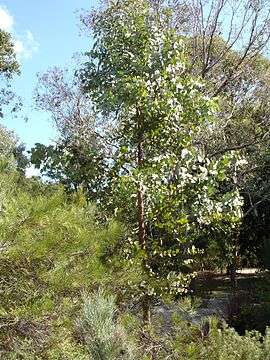Eucalyptus dumosa
| White mallee | |
|---|---|
 | |
| Eucalyptus dumosa, Melbourne | |
| Scientific classification | |
| Kingdom: | Plantae |
| Clade: | Angiosperms |
| Clade: | Eudicots |
| Clade: | Rosids |
| Order: | Myrtales |
| Family: | Myrtaceae |
| Genus: | Eucalyptus |
| Species: | E. dumosa |
| Binomial name | |
| Eucalyptus dumosa | |
 | |
| E. dumosa, field distribution | |
.jpg)
Eucalyptus dumosa, commonly known as the Walkerie mallee,[1] Congoo mallee, Cong mallee, Dumosa mallee[2] or the White Mallee, is a mallee of south eastern Australia. Mallee is the Wergaui/ Wotjobaluk word for this species.[3]
Description
The tree typically grows to a height of 4 to 8 metres (13 to 26 ft)[4] and occasionally 12 metres (39 ft)[5] and a width of 4 to 5 metres (13 to 16 ft) and has an open canopy. It has an open, bushy, spreading habit.[4] The bark is smooth, whitish or yellow-white, weathering to grey or pinkish-grey, on larger stems there is usually a stocking of thin grey-brown fibrous bark.[6] The bark sheds in long thin ribbons.[5]
Adult leaves are stalked, alternate, lanceolate 10 centimetres (3.9 in) long and 2 centimetres (0.8 in) wide, concolorous dull green to grey-green.[6]
Clusters of white flowers appear in late summer to mid autumn.[6] The infloresences are seven-flowered umbellasters with a terete or angular peduncle that is 10 to 16 mm (0.39 to 0.63 in) long. It has pedicels that are terete and 1 to 3 mm (0.04 to 0.12 in) long and cylindrical buds. The fruit that forms later is cylindrical or ovoid and 6 to 9 mm (0.24 to 0.35 in) in length with a diameter of 5 to 7 mm (0.20 to 0.28 in).[5]
Range
It is found in the relatively dry country of South Australia from the northern Flinders Ranges and Murray Mallee eastwards to central western New South Wales and north western Victoria.[3] E. dumosa is usually co-dominant in mallee shrubland on red aeolian sands.[5]
It is one of the most wide-spread mallee species.[7]
Uses
The leaves are steam distilled as a commercial source of cineole based eucalyptus oil.[8]
It is used as a component of mass plantings along with other mallee species on wide roadside verges as a screen, wind-break, erosion control or a shade tree. Indigenous Australians use the tree as a source of food, drink, medicines and to make containers and implements.[4]
A sweet manna-like substance is produced upon the leaves of the tree, it is made into a drink. The bark of young roots is baked and eaten, it is sweet, resembling malt in flavour.[9]
The 1889 book 'The Useful Native Plants of Australia’ records that common names included "Bastard Box" and "Coolibah" and that "These Eucalypts [sic.], amongst others, yield water from their roots. It also mentions that, "This shrub yields a kind of manna called Lerp or Larp by the aboriginals [sic.]. It is the nidus of an insect, and consists of starch-like substance, which is eaten in summer by the aborigines [sic.] of the mallee country of Victoria. It somewhat resembles in appearance small shells; it is sweet, and in colour white or yellowish-white. According to Dr. Thomas Dobson, of Hobart, the insect which causes the Lerp to form is Psylla Eucalypti. It is probably formed on the leaves of other mallee Eucalypts. This substance occurs on the leaves, and consists of white threads clotted together by a syrup proceeding from the insect (Psylla Eucalypti) which spins those threads. It contains, in round numbers, of water 14 parts, thread-like portion 33 parts, sugar 53 parts. The threads possess many of the characteristic properties of starch, from which, however, they are sharply distinguished by their form. When lerp is washed with water the sugar dissolves and the threads swell but slightly, but dissolve to a slight extent, so that the solution is coloured blue by iodine. The threads freed from sugar by washing consist of a substance called Lerp-amylum. " Lerp-amylum is very slightly soluble in cold water, not perceptibly more so in water at 100°"[10]
It is also suitable to produce large amounts of biomass, able to make 10 to 20 metric tons (11 to 22 short tons) per hectare per year. In wheatbelt regions it is also beneficial as the tree will reduce salinity, give shade to stock, act as a windbreak and reduce erosion.[7]
See also
References
- ↑ Dean Nicolle. "Native Eucalypts of South Australia". Retrieved 16 October 2016.
- ↑ "Eucalyptus dumosa". Lucid. Retrieved 16 October 2016.
- 1 2 "Mallee". Viridians. Retrieved 16 October 2016.
- 1 2 3 "Eucalyptus dumosa White Mallee". Plant Selector. Botanic Gardens of South Australia. Retrieved 16 October 2016.
- 1 2 3 4 "Eucalyptus dumosa A.Cunn. ex J.Oxley". PlantNet. Royal Botanic Garden, Sydney. Retrieved 16 October 2016.
- 1 2 3 Brooker, M.I.H. & Kleinig, D.A. Field Guide to Eucalyptus, Bloomings, Melbourne 2001
- 1 2 "Mallee". Biomass Producer. Australian Government. 2013. Retrieved 6 May 2017.
- ↑ Boland, D.J., Brophy, J.J., and A.P.N. House, Eucalyptus Leaf Oils, 1991, p6 ISBN 0-909605-69-6
- ↑ "Eucalyptus dumosa - Cunn". Plants For A Future. Retrieved 16 October 2016.
- ↑ J. H. Maiden (1889). The useful native plants of Australia : Including Tasmania. Turner and Henderson, Sydney.